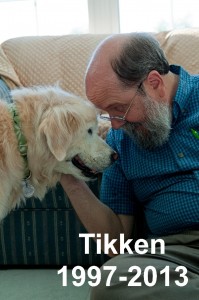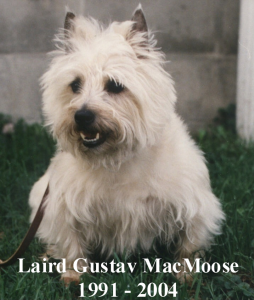
< A version of this article was published in the December 2015 issue of Down East Dog News>
My wife Paula and I have been part of the pet care services industry for over 20 years and in that time we have seen many changes. Last month I started writing about the changes we have seen in pet food and pet nutrition. I discussed how brands have changed, the need for consumers to be knowledgeable, the verbiage used by pet food companies, protein choices, and industry consolidation. Pet food is a big topic, and there have been many more changes that I address below.
Gus’ Story – Last month I started a story about how our Cairn Terrier Gus’ issues with UTI’s and crystals initiated our journey with learning about pet nutrition. It was not until after I sent my column off to the editor that I realized that I had not finished the story.
We eventually found a brand of food, Wysong, and some Wysong supplements

that cured Gus’ UTI and crystal issues. It was our first experience with what at the time was classified as an ultra-premium pet food. We learned a great deal from Dr. Wysong and his distributor here in Maine, the late David Hinson. Their commitment to quality nutrition should be an inspiration to all pet food companies.
Formula Proliferation – Twenty years ago the most common form of pet food was dry kibble, still the number one choice for food. Pet food companies offered kibble formulas for puppies, adult dogs, and overweight dogs. Then came senior and a few years after that we started seeing the large breed puppy formulas and in some cases, food for specific breeds of dogs. Many experts in pet nutrition, like Dr. Wysong, argue that the proliferation of formulas is more about SKUs, marketing and shelf space than nutrition. I believe their position is quite sound if we look at what and how canines eat in the wild. The nutritional rationale for all of these formulas is not necessarily based in science or good nutrition and often makes it harder for the consumer to make a good decision.
Recalls – We have seen numerous pet food recalls in the past twenty years just as we have with human food. As long as good quality food remains perishable, which I suspect will be forever, there are going to be recalls. A recall in itself as not a bad thing, but a lot depends on how the company handles the recall. The companies the handle recalls the best are the ones that offer full disclosure early in the process, and that keep their distributors and retailers informed. It is always our goal to contact our clients to let them know about a recall before they hear about it on the internet.
Misleading Advertising – Pet food advertising is made to appeal to people because let’s face it, your dog or cat is not making the decision of what food you will buy. Unfortunately, advertising can make any food look and sound wonderful. What makes it even worse is when the claims made in those ads are false; as has been the case with the ads by a pet food company that many would argue currently have some of the most appealing ads on television. Those ads claim this company never uses low-grade ingredients like poultry by-product meal and insinuates that food made by other companies do use low-quality ingredients. This company was first sued in the spring of 2014 and has now admitted in Federal court that they are indeed guilty of using the low quality ingredients they claimed not to use. What makes this even more incredulous is that the company is not accepting responsibility for their actions but instead is blaming the companies that make their food and their suppliers. Yes, you read that correctly. There are companies out there that only market pet food and subcontract the development and manufacture of their food to other companies. In my mind, that is not a real pet food company but instead is an accident waiting to happen. That is why we prefer dealing with small, family-owned companies that buy raw ingredients from suppliers that they know, manufacture their food in their own plant, and then market it to independent stores like ours.
Dietary Rotation – For years, the standard recommendation from pet food companies and many veterinarians has been to find a food that your pet does well on and then NEVER change it, as any change could upset your pets digestive system. It is easy to understand why a pet food company would like this approach; it keeps profits going into their coffers.
One of the first things we learned from Dr. Wysong was his belief in the benefits of dietary rotation. Wysong produces a puppy and senior formula, as well as a couple of adult formulas; however, rather than feeding them strictly by age Dr. Wysong recommends you rotate among the diets. We would feed our dogs growth in the summer, when they were more active, and senior in the winter when they were less active, and standard adult formulas in the spring and fall. If one studies how wild canines eat, the concept of dietary rotation also makes perfect sense as what they eat varies widely, day to day. We are glad to see that in the past few years some of the pet food companies that we deal with now offer multiple adult diets and now also recommend dietary rotation.
Raw Diets & Homemade Diets – In 1998 Paula and I attended a seminar to hear Dr. Ian Bilinghurst talk about raw diets for dogs. The Australian veterinarian and author of Give Your Dog A Bone was one of the first veterinarians to discuss the benefits of feeding what he called BARF; Biologically Appropriate Raw Food. What Dr. Bilinghurst was saying is essentially what experts on human nutrition have been emphasizing; eat fresh whole food (meat, dairy, fruits and vegetables) and avoid highly processed food. Dry pet food, no matter who makes it, is one of the most highly processed foods on the planet.
 Paula and I sought more knowledge about raw pet food, and eventually started feeding our pets a raw diet in 2001. Green Acres began selling commercial, raw frozen diets at the beginning of 2002. At first, we fed one raw meal per day and a meal of kibble for the second meal of the day. When we started to see the changes in our dogs we switched to 100% raw, which is what we continue to do today. We practice dietary rotation, switching proteins every time we purchase food and readily switch between brands. I cannot prove it, but I do believe that a raw diet played a significant role in our Golden Retriever Tikken living past her 16th birthday.
Paula and I sought more knowledge about raw pet food, and eventually started feeding our pets a raw diet in 2001. Green Acres began selling commercial, raw frozen diets at the beginning of 2002. At first, we fed one raw meal per day and a meal of kibble for the second meal of the day. When we started to see the changes in our dogs we switched to 100% raw, which is what we continue to do today. We practice dietary rotation, switching proteins every time we purchase food and readily switch between brands. I cannot prove it, but I do believe that a raw diet played a significant role in our Golden Retriever Tikken living past her 16th birthday.
What Does the Future Hold?
The only thing I can predict with any certainty is that the pet food world will continue to change and that we as consumers will need to remain diligent. More and more people are considering feeding raw diets or at least fresh whole food. I expect that trend to continue to grow. The pet food world is threatened by the same thing as the world of human-food; industrialization and consolidation. Hopefully as we become more aware of the importance of fresh, whole, locally-sourced food for ourselves that will change for pet food as well.
Other Posts You May Find Interesting
Nutrition – Which Brand of Pet Food is the Best? – Part 1 – <Click Here>
Nutrition – Which Brand of Pet Food is the Best? – Part 2 – <Click Here>
Nutrition – Which Brand of Pet Food is the Best? – Part 3 – <Click Here>
Nutrition – Why Rotating Diets Makes Sense – <Click Here>
Nutrition – Determining True Pet Food Costs – <Click Here>
Pet Nutrition – How Much Fat Is In Your Pet’s Food? <Click Here>
______________________________________________________________________________
Don Hanson is the co-owner of the Green Acres Kennel Shop (greenacreskennel.com) in Bangor. He is a Bach Foundation Registered Animal Practitioner (BFRAP), Certified Dog Behavior Consultant (CDBC), Associate Certified Cat Behavior Consultant (ACCBC) and a Certified Professional Dog Trainer (CPDT-KA). He produces and co- hosts a weekly radio show and podcast, The Woof Meow Show heard on The Pulse AM620 WZON and streamed at http://www.wzonradio.com/ every Saturday at 9 AM. A list of upcoming shows and podcasts of past shows can be found at www.woofmeowshow.com. Don also writes about pets at his blog: www.words-woofs-meows.com.
©2015, Donald J. Hanson, All Rights Reserved <Click for Copyright and Use Policy>


